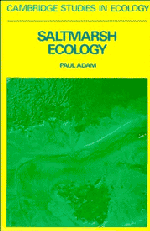Book contents
- Frontmatter
- Contents
- Preface
- Abbreviations for frequently-occurring species names
- 1 General features of saltmarshes and their environment
- 2 The saltmarsh biota
- 3 Variation in saltmarsh vegetation
- 4 Coping with the environment
- 5 Plant life history studies
- 6 Saltmarshes as ecosystems
- 7 Modification, management and conservation
- References
- Index
7 - Modification, management and conservation
Published online by Cambridge University Press: 04 April 2011
- Frontmatter
- Contents
- Preface
- Abbreviations for frequently-occurring species names
- 1 General features of saltmarshes and their environment
- 2 The saltmarsh biota
- 3 Variation in saltmarsh vegetation
- 4 Coping with the environment
- 5 Plant life history studies
- 6 Saltmarshes as ecosystems
- 7 Modification, management and conservation
- References
- Index
Summary
Many of the world's major cities are sited on estuaries. In consequence, saltmarsh often provides the only extensive areas of apparently natural vegetation close to major conurbations. Saltmarshes are almost always dominated by native species and look very different from the farmland which may fringe the city – however, there are many human impacts on saltmarshes and the species and community composition of many sites may be a consequence of these impacts. If these areas are to be managed, it is important that decision makers are aware of past impacts and the sensitivity of the ecosystem to changes in the pattern of human impacts.
Grazing
Livestock have been grazed on saltmarshes for centuries. At the present time, grazing is an important use of saltmarshes in northern Europe (Dijkema 1984d), eastern Canada (Roberts & Robertson 1986) and Japan (Ishizuka 1974), and occurs widely on marshes from high latitudes to the tropics. In Europe, grazing is most intensive in northern and central regions and is less intensive in the south (Beeftink 1977a). Grazing may, however, be an important ecological factor even on sites where it is carried out on an irregular casual basis.
- Type
- Chapter
- Information
- Saltmarsh Ecology , pp. 356 - 390Publisher: Cambridge University PressPrint publication year: 1990
- 1
- Cited by



